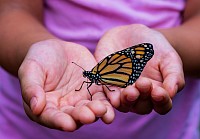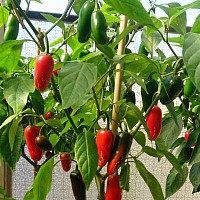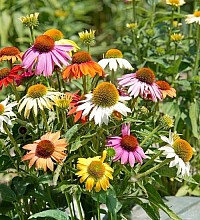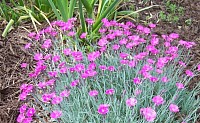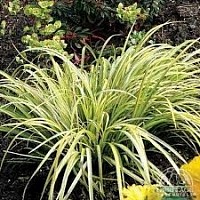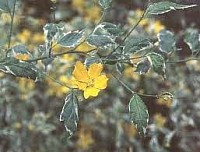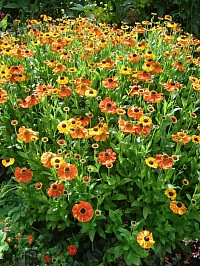My Perennial Thoughts
New Season Is Off To A Great Start
Unseasonably warm temperatures have allowed us to open up a few weeks earlier than usual.
With that said, we will be offering only the perennials for sale at this time. Annuals and herbs will be offered as usual around Mother's Day, because you never know about our weather.
2023 in Review
2023 has been a good year for us. Popularity of native plants and Monarch butterflies has grown by leaps and bounds.
Our T-shirts and VIP memberships have been a big hit and our VIP members have enjoyed hiking and hanging out on our Native plant Trail and Conservation Field.
We are grateful to everyone who donated to the construction of our butterfly house and the continuing expansion of the nursery.
Incidentally, I had to have cataract surgery on both eyes in November and early December, and am happy that the surgeries are behind me. I'm healed and looking forward to 2024 with clear vision.
We look forward to opening in March (weather dependant) for the 2024 growing season.
Thank you all for a great 2023.
A Season of Butterflies
This season started off quickly in April and we hit the ground running. Customers have taken a huge interest in native plants and pollinator plants...and so have we.
Most people know that our pollinator insects are needing human help due to loss of habitat and food supply, so we have decided to assist in a big way by raising butterflies and their host and nectar plants.
I personally was inspired and educated by a friend and customer who had raised, tagged, and released hundreds of Monarch butterflies over the years. She got us started with a butterfly habitat cage and advice on caring for eggs and larvae.
I decided to order 10 monarch eggs/larvae from a local producer who ships these fragile creatures via USPS. They arrived in fine condition and were already eating inside of their box.
It took about 2 weeks and we did have 2 casualties due to my own clumsiness, but 8 adults: 6 females and 2 males, were finally released.
Seeing the first butterfly emerge all scrunched up from its chrysalis is like witnessing a birth, and for me, was kind of emotional.
So now we have ramped up our efforts by purchasing more habitats, growing more host plants and nectar plants, and planning for the transformation of our 7 acre field into a butterfly and pollinator preserve.
So far, we have released 8 adult Monarch butterflies: 6 females and 2 males ; currently have 12 more chrysalids waiting to transform, along with several more smaller caterpillars, and about 50 collected eggs. One of our own female monarchs(we hope) returned to lay eggs on our Swamp Milkweed while customers and I got to watch.
Some people have mixed feelings about collecting eggs from the wild, but I think that since humans have caused this problem for Monarchs and other pollinators, humans need to fix it. One way of fixing it, is to make sure as many larvae as possible make it to adult-hood. Monarchs and other butterflies and their larvae have many predators like birds, toads, mantids, spiders, assassin bugs, and more. Plus humans destroy the habitats and host plants which Monarchs and other pollinators use for egg laying. There are diseases and parasites as well. So the best way to ensure survival is to raise these babies enclosed in a mesh habitat which keeps them safe, clean, and well fed. Just think, if everyone raised 10 Monarchs to adulthood, what an impact this would make on their dwindling numbers.
For the future, we will convert our 7 acre field to a butterfly & pollinator habitat. It will take a lot of work and resources, so we are looking into the possibility of applying for a state grant. We will be setting up a committee for this project and if anyone would like to help out, just let us know.
Fall and Beyond
Fall is in full swing and what a great seasoon its been. Nice weather though a little dry, has afforded us some extra time for growing and planting.
Over the next month I will be potting up hundreds of perennials as we prepare to shut down the nursery.
It's kind of a sad time as we say goodbye to our resident Mantids and other beneficials who's short lives are coming to an end. But I take heart in the fact that a new brood of beneficial buddies will be waiting patiently for the welcoming warmth of May.
You are always welcome to visit the nursery but please give me a heads up that you are coming so I know to be here.
I am looking forward to a little rest over the winter, so that I can get new seeds ordered or collected, update websites, cleanup the greenhouses, and plan for next March-April's reopening.
The Heat of Summer Has Arrived
The lazy hazy days of summer are here and we sometimes wilt along with our plants. We know that we need to stay hydrated during hot periods and that goes for our plants too.
I've been asked quite often "when is the best time of day to water" and my answer always is "whenever you are able to do it" because most of us have busy schedules with limited time. But there are more ideal times of day to water if you can swing it.
Early morning is my pick for best time of day. When plants are watered very early, they have time throughout the day for water to evaporate off of leaves which helps with disease control.
Evening watering is my second choice because there are a few disadvantages which include:
- Plants sit wet overnight which encourages leaf spots and disease
- Overnight wetness makes it much easier for slugs to frolic about with ease all over our plants, while dining upon them with wild abandon...lol Hard to imagine a slug frolicking about but you get the picture.
- Overnight wetness also encourages algae growth on moist surfaces.
If you cannot water in the morning or early evening, then any time you are able is acceptable, just remember a few things:
- Water at the root zone and do not sprinkle overhead during the heat of the day. Overhead watering will waste a lot of water because much of it is lost to evaporation before the plants can even use it. Additionally, splashing water on leaves when the sun is blazing hot is a sure way to burn some plant leaves as the water drops can act like little magnifying lenses on the leaf surface.
- If your plants are on a slope, make sure there is a layer of mulch to prevent water from running off of dry soil. Mulch is a good idea anyway because it helps keep soil temperatures from fluctuating too much. But when it comes to mulch , a little goes a long way and especially with perennials, you do not want to go very thick. Use 1/2" of something like pine fines or other finer mulch. If you choose to use new mulch which has not been properly aged, make sure you add some nitrogen fertilizer to the bed. Otherwise, as the wood in the mulch decomposes, the bacteria doing the decomposition will start taking nitrogen from the soil and plants will turn yellow. Also, if your mulch smells sour, do not apply it to plants or near lawns because it will produce fumes which burn plant surfaces. You will have to allow the mulch to air out for awhile.
- If you allow the bed to dry out after mulching with shredded bark type mulches, the mulch can harden and actually repel the water. In this case, you would need to take a rake and rough up the mulch surface.
So remember, if doing day time watering, soak the base of the plant and do not sprinkle the top.
Now enough about watering, let's talk STRESS.
Plants have ideal growing temperatures up to about 90 degrees F. Once temperatures exceed 90, plants begin to feel some stress...I mean, we ALL do right?. Most plants can take a few days of 90s, but if the heat lasts for longer periods, then you should be aware of a few things that can occur:
- One of the first things you'll notice is plants may wilt even if watered. This often occurs in large-leafed plants like hydrangeas and it happens because the leaves are losing moisture faster than the roots can bring it in. Plants will also wilt if we've had a stretch of cloudy weather and all of a sudden, we have sun and heat to which the plants need to re-acclimate.
- Plant growth will slow or stop altogether and flowering may stop as well. You will have to just wait this out. Do not add more fertilizer at this time as it can actually work to the plant's detriment and cause burning.
- Yellowing of leaves which is a form of iron chlorosis. This occurs during hot and dry periods. You can amend the soil with iron products or you can apply chelated iron to the plant. It's a temporary fix until the temperature drop.
- And then there's the bugs! Yep...plants under stress become more susceptible to disease and more attractive to insects. You need to be vigilant and look out for increases in thugs like aphids, lacebugs, japanese beetles, spider mites, and more. Hot temps accelerate the insects' growth and reproduction rates....oh..and did I mention the ants? Yes, they drive me nuts...building their nests in every plant, under every pot; creating high rise condos in my stacks of containers. Last week I found a new mini-nest inside of a box cutter...are you kidding me....a box cutter! How lazy can a queen ant get! Anyway, I digress...
- Also, make sure that you situate a plant in a location for which it is suited. It's sad to see a beautiful Painted Fern, turn brown from sun scald, or an Astilbe develop dry crinkled leaf edges from full sun and drought like conditions. If you have full sun and dry soil, then try to pick plants which can handle these conditions. There are lots to choose from. And if you don't know, please ask.
- Lastly, if you plan to go on a 2 week vacation, please plan to have someone water any newly transplanted perennials in the absence of rain. Your new plants will need to be watered at least once a week while the roots are establishing.
Now Go Enjoy Your Summer!
Some Plants Are Difficult to Find This Spring
Spring has started out with its usual rush to get everything done..seeds planted, perennials transplanted and repotted and new plants ordered.
Strangely, this year one of the hardest things to find are several seed grown varieties of perennials. I try to grow as much from seed as possible because it keeps costs lower, but I am having a hard time finding the seeds that I need for such plants as Echinacea ' Cheyenne Spirit', Delphinium 'Fantasia', and many others.
Additionally, certain professional growing mixes have become scarce as well. And the price of lumber....ugh....
Then to make matters worse, shipping has been horrendous. Many seeds are shipped via USPS and it has taken weeks for seeds to arrive that normal arrive in 7 days or less.
I guess Covid is the problem.. I sure will be happy when this is behind us, won't you?
Spring Is Off To A Busy Start
Spring has already gone bonkers for us. Sales are brisk and patios and plants are in big demand.
We will be growing all season so don't be disheartened if a plant is marked unavailable or sold out. We grow multiple crops and when you visit the nursery, you will see many plants in various stages of growth.
We have a couple of cold nights to get through first though, and then things will get back to the hustle and bustle that we all love.
This year you can walk through the nursery if you let us know you'd like to shop in person, but we still ask that you wear a mask even if vaccinated...yes, we hate masks too, but its a small price to pay for keeping our neighbors safe.
Yes, it's spring and lets enjoy it to the fullest.
Happy Spring!
Well, spring is finally here and we are rushing to fill the benches and clean up the nursery.
The perennials are breaking dormancy now and looking pretty good.
We had such a mild winter that we lost very few and in fact, some tender perennials like pineapple sage actually survived.
We can't wait to see all of you again this year
Winter is Here
All plants are nestled in their wintering beds as we impatiently wait for winter to start showing signs of giving into spring.
Right now is seed starting time and we are ordering and sowing seeds.
Can't wait to see the first signs of spring which should be shortly...buds will swell, crocuses and glory of the snow will pop.
Ringo Has Arrived
Ringo has been with us just about a month and he's grown quite a bit. He's gone from 14.3 lbs up to 25 lbs and he is still growing into his big feet. We think he will top out around 75 lbs.
Ringo is quite the handful as he learns about the world around him. He loves exploring the nursery, checking out the toads, jumping into the stream and digging in the sand pile. He also barks and whines and chews alot...lol
We introduce him to most of you that visit the nursery so he can get to know everyone.
SoonTo Be Joining Us: Meet Ringo
Check out Ringo! He's about 5 weeks old and we will be welcoming him to the family at the beginning of September.
After our 14 year old smooth collie Gemma died 3 weeks ago, we decided on another smooth, but wanted a boy of a different color.
Though we miss our Gemma and know she can never be replaced, we also know she would have loved a new puppy in the house.
So we are looking forward to the chaos and joy a new puppy will bring.
Kerria japonica picta - Coming Soon!
Unusual for a Kerria and much more delicate looking, this variety of kerria doesn't grow over 3 feet tall with an equal spread. Picta has an almost lacy look due to the white variegated leaves. Care is the same as the more humongous Kerria japonica with which most of us are familiar.
Picta will be sold in 1 gallon pots and will be available shortly.
My Best Friend Has Died
My heart is empty and broken as we had to say goodbye to our beautiful collie Gemma yesterday afternoon. Some of you have met her...she is the one who greeted you at the nursery.
Our papillion, Rocky, also in the photo, died last October. Its a double hit of pain and sadness.
They had lived their lives running and chasing frisbees, barking, diving into Israel Creek and just running the show.
There are no words to describe the hole in my heart and the silence that is deafening.
Summer in Full Swing and Covid-19
It's been a hot one for sure. But I'm not complaining. For me,as a grower, the heat and humidity of summer are ideal for starting cuttings and pushing new growth. Some cuttings will root in as little as 2 weeks during these sultry days.
Through pouring sweat, I am loving the heat. Many people look forward to the cooler days of fall, but not me. So for now, I'm going to revel in the steaminess of the season. It also keeps my mind off this Covid mess. Won't it be nice when this has all passed and we get back to normal.
And while I'm on the subject of Covid, I want to mention that at the nursery we are still wearing masks and social distancing. I watch the infection numbers closely and the folks in our area are doing a great job flattening the curve around here. Let's keep up the good work.
I have also been researching this disease a bit, and have learned that there is an ideal humidity level for transmission of the virus. Under 40%, the virus can live longer on surfaces, over 60% humidity, the virus can hang in the air longer. Humidity levels between 40-60% are thought to somewhat inhibit the virus. So with that in mind, we wear our masks around here when the humidity outside exceeds 60%. The masks make it harder to breath when it's hot out, but that is a small price to pay for avoiding passing on the infection to others.
